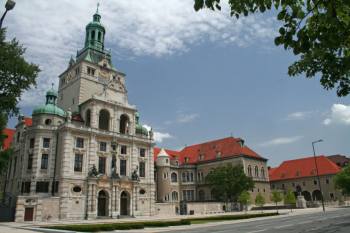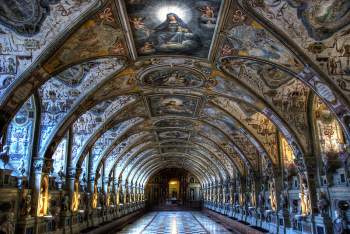|
|
| |
GERMANY
MUNICH MUSEUMS
Deutsches Museum The Deutsches Museum in Munich, is the world's largest museum of technology and science, with approximately 1.5 million visitors per year and about 28,000 exhibited objects from 50 fields of science and technology. The main site of the Deutsches Museum is a small island in the Isar river. In addition to the main site on the Museumsinsel, the museum has two branches in and near Munich. The Flugwerft Schleißheim branch is located some 18 kilometers north of Munich's city center close to Schleißheim Palace. The "Flugwerft Schleißheim" displays various interesting airplanes. . Among the more prominent exhibits is a Horten flying wing glider built in the 1940s. The collection also includes a German construction of the VTOL (vertical take off and landing) plane developed in the 1950s and 1960s. Also a range of Vietnam era fighter planes as well as Russian planes taken over from East Germany after the reunification are shown. The latest branch of the Deutsches Museum, located at Theresienhöhe in Munich, opened in 2003 and is called the Deutsches Museum Verkehrszentrum and is focused on transportation technology. The branch located in Bonn was opened in 1995 and focuses on German technology, science and research after 1945.
For more information please contact Deutsches Museum,
Museumsinsel 1,
80538 München,
Tel: +49 - 89 - 2179 - 1, E-mail: information@deutsches-museum.de
 Deutsches Museum, view of the museum island Copyright © Benutzer:Bimbelmoser
Bavarian National Museum The Bavarian National Museum in Munich is one of the most important cultural history museums in Europe. The art historical collection displays artworks in a tour through more than forty rooms from the hall for late antiquity and Romanesque art via the rooms for Gothic, Renaissance, Baroque and Rococo art to the exhibits of Classicism and Art Nouveau. The museum exhibits especially ivory reliefs, goldsmith works, textiles, glass painting, tapestries and shrines. The displayed sculptures were created by foremost sculptors like Erasmus Grasser, Tilman Riemenschneider, Hans Multscher, Hans Leinberger, Adam Krafft, Giovanni Bologna, Hubert Gerhard, Adriaen de Vries, Johann Baptist Straub. The museum is also famous for its collections of courtly culture, musical instruments, furnitures, oil paintings, sketches, clocks, stoneware, majolica, miniatures, porcelain and faience. It has probably the world's best collection of the Nymphenburg porcelain figures of Franz Anton Bustelli (1723-63). The folklore collection houses for example traditional Bavarian furnitures, rural pottery, crockery and religious folklore including an outstanding collection of Neapolitan, Sicilian, Tyrolian and Bavarian wood carvings.
For more information and enquiries please contact Bayerisches Nationalmuseum,
Prinzregentenstraße 3,
D-80538 München, Tel: 0049 - 89 - 211 24-01,
E-mail: bay.nationalmuseum@bnm.mwn.de
 Bavarian National Museum Copyright © Oliver Raupach
Munich ResidenzThe Munich Residenz is the former royal palace of the Bavarian monarchs in the center of the city of Munich, Germany. The Residenz is the largest city palace in Germany and is today open to visitors for its architecture and room decorations, and displays from the former royal collections. The complex of buildings contains ten courtyards and the museum displays 130 rooms. The Hall of Antiquities (Antiquarium), built in 1568-1571 for the antique collection of Albert V (1550-1579) by Wilhelm Egkl and Jacobo Strada, is the largest Renaissance hall north of the Alps. The baroque era is represented by the Papal Rooms. The neoclassical epoch is represented especially by the Charlotte Rooms. The treasury collection is one of the most important in the world and spans 1000 years from the early Middle Ages to Classicism. On display are royal insignia, crowns, swords, goblets, goldsmith work, rock crystal, ivory work, icons and numerous other treasures like precious tableware and toiletries. The Residenz houses also the Bavarian state's coin collection. With more than 300,000 coins, medals and banknotes from the ancient world to the present time it is one of the world's leading collections. Additionally to the rich accumulation of furniture, paintings and sculptures, the museum contains bronze work, clocks, tapestries, porcelain and several special collections.
For more information and enquiries please contact National Museum Visitor Services,
Genthiner Straße 38, 10785 Berlin, Tel: +49(0)30 266 42-4242, E-mail: service@smb.museum
 The Renaissance Antiquarium of the Residenz Copyright © Patrick Theiner
|
|
|
|
|